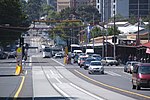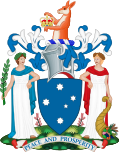Melbourne Continuation School
1905 establishments in AustraliaDefunct schools in Victoria (Australia)Educational institutions established in 1905Public high schools in MelbourneVictoria (Australia) school stubs
The Melbourne Continuation School was Victoria's first state secondary school, established in 1905, from the initiative of Director of Education, Frank Tate. The school was founded on the old National Model School in Spring Street, with principal Joseph Hocking. The opening of the school marked the beginning of secondary state education in Victoria. The school site is now occupied by the Royal Australasian College of Surgeons.
Excerpt from the Wikipedia article Melbourne Continuation School (License: CC BY-SA 3.0, Authors).Melbourne Continuation School
Spring Street, Melbourne East Melbourne
Geographical coordinates (GPS) Address Nearby Places Show on map
Geographical coordinates (GPS)
| Latitude | Longitude |
|---|---|
| N -37.808888888889 ° | E 144.9725 ° |
Address
College of Surgeons' Gardens
Spring Street
3002 Melbourne, East Melbourne
Victoria, Australia
Open on Google Maps











